
MAY CONTAIN NUTS

Search Shorpy
SHORPY ART

Framed or unframed, desk size to sofa size, printed by us in Arizona and Alabama since 2007. Explore now.
Join and Share
Ad-Free Shorpy
Shorpy is funded by you. Patreon contributors get an ad-free experience.
Learn more.

Recent comments
- Now that's a service station!
- Union Switch & Signal
- Still there -- but not a garage any more
- Must be good breezes there
- Wowzers
- Treescaping
- Still Life With Operator
- +112
- Rear View
- Way in the back --
- Button It Up
- And with an eye on the time ...
- Working in an enclosed ashtray
- Rear View Mirror?
- Tobacco cam
- Basic fact I learned only later in life
- Put a Lid on it!
- Pinstripes in the Tower
- Sound enhancement
- 3438 in '38
- Second Career
- Their days are numbered
- Only the Sensor
- Train control mechanism
- Rarest of the Rare?? & Classy 3400 Class
- Control Mechanism
- Those standpipes
- Wrenches
- International D-40 I believe
- Job prospects
Member Photos
The Shorpy
Printporium
Printporium
Search Shorpy
Search results -- 30 results per page
- Family Gathering: 1958
- ... crime.
Let me guess It's eight o'clock Sunday night. Dinner was great, and dessert divine. After second cups of coffee and ... Posted by Mvsman - 09/14/2011 - 4:56pm -
- Summertime Santa: 1956
- ... Sam! Remember the nerd played by Martin Short on Saturday Night Live about 20 years ago? Suspenders were something Moms bought so they ... Posted by Samuel1940 - 09/20/2011 - 1:20pm -
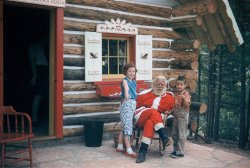
- Loading Zone: 1939
- ... movie!
Calling George Raft Shades of "They Drive by Night."
(The Gallery, Cars, Trucks, Buses, John Vachon, Minneapolis-St. ... Posted by Dave - 09/13/2011 - 8:21pm -
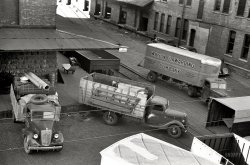
- Chicken in the Ruff: 1960
- ... the state line several times during a teenage boy's dream night. Good lord to be 14 again!
(The Gallery, Cars, Trucks, Buses, ... Posted by Dave - 11/04/2013 - 5:23pm -
![Chicken in the Ruff: 1960 Extra credit assignment: Identify the cars. (The answers: 1960 Ford Starliner on the left; 1960 Studebaker Lark on the right.)
Spring 1960. "Efforts of John F. Kennedy's campaign team, including members of his family, in West Virginia during Kennedy's quest for the 1960 Democratic presidential nomination. Includes brother Bob at a drive-in in Bluefield." From photos by Bob Lerner for the Look magazine article "The Kennedys: A Family Political Machine." 35mm negative. View full size.
Love that Lark!Nineteen sixty was the first year Studebaker offered its Lark model as a convertible, like the one on which Kennedy is seated. Studebaker differentiated six- and eight-cylinder versions with a Roman numeral "VI" and "VIII," respectively, after the "Lark" badging on the front fenders (I can't quite make out if this one is a VI or VIII).
While sitting on cars wasn't always bad form, especially in the days of heavier-gauge sheetmetal, putting the soles of one's shoes directly on a car's paint job (as RFK is doing to that Ford product parked next to the Lark) is a definite no-no.
1960 Fordon the left, 1959 or 1960 Studebaker Lark on the right
Great photoI would love to see that "chicken on a bicycle" neon sign in action!
Don't scratch my Starliner!!The car on the left is a new 1960 Ford Starliner two door hardtop. The one on the right is a Studebaker Lark. This is a top of the line convertible, but it has a radio "delete" plate on the dash.
On the leftI'm almost sure the car on the left is a new 1961 T-Bird.
[As noted below, the car on the left is a 1960 Ford Starliner. The fender ornament and chrome thingamabobs on the roof pillar are the main clues.]
Snap OnThis picture reminded me of the 2 convertibles that I owned, a 1958 Chevy Impala and a 1963 Olds Starfire. They looked great with the tops down and enclosed in the snap-on faux leather boots that covered them. The car in the photo has the top down but without the boot cover on. After a while I stopped using the cover because it was a real pain to fasten.
Sole solutionRFK's soles are carefully resting on the chrome trim so it's permissible.
Bluefield TwoferBluefield is one of those areas where a savvy pol like our beloved Bobby could have worked two states while thinking he was in only one. The last time I was there (early '60s), my cousins popped me back and forth across the state line several times during a teenage boy's dream night. Good lord to be 14 again!
(The Gallery, Cars, Trucks, Buses, Eateries & Bars, LOOK, Politics)](https://www.shorpy.com/files/images/SHORPY_04891u1.thumbnail.jpg)
- Grill Noir: 1940
- ... shop in Durham, North Carolina." George's Grill, open all night. 35mm nitrate negative by Jack Delano. View full size.
Curb ... the smell of cooking hamburger and onions on a hot summer night, hear the sizzle on the grill, see the steam rise, and feel the warmth of ... Posted by Dave - 08/05/2014 - 9:35am -
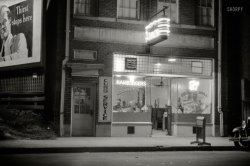
- Apartment 17: 1912
- ... roses in dirty, poorly lighted kitchen. They work some at night. Pauline, 6 years old, works after school. Peter, 8, works until 8 p.m. ... Posted by Dave - 09/30/2012 - 4:09pm -
![Apartment 17: 1912 January 1912. New York. "Basso family, 2 Carmine Street, Apt 17. Making roses in dirty, poorly lighted kitchen. They work some at night. Pauline, 6 years old, works after school. Peter, 8, works until 8 p.m. Mike, (cross-eyed), 12 years old, until 10 p.m. Father keeps a rag shop." Photo by Lewis Wickes Hine. View full size.
A million barrels of beer on the wallIn late 19th century New York City, George Ehret was its most successful brewer, and the partly obscured line on the calendar page bottom (“1,000,000 barrels sold every year”) was no empty brag. He made a trip to Germany during the First World War, couldn’t get back to the U.S., and the government, caught up in anti-German actions, seized his business. When he managed to return, he worked to straighten everything out, and sponsored a number of pro-American ads for War Bonds. Here's a calendar similar to the one in the Basso home. (Note the Star of David incorporated in the company logo. He might not have made it out of WW II Germany.) What the war couldn’t do to Ehret’s business Prohibition did; the company floundered and in 1935 was bought by the Jacob Ruppert Brewery, also in New York.
[That "Star of David" -- the hexagram or Bierstern (beer star) -- is a symbol of the brewers' guild in Germany. - Dave]
Apartment 17: 1912This is Joe Manning, of the Lewis Hine Project. I did some quick research this morning. In the 1940 census, Mrs. Basso (first name Columbia) was a widow, and lived in NYC with three sons, John (50), Michael (40) and Peter (36). John is not in this picture, but Michael and Peter are. John was working, oddly enough, as a flower dyer. Michael was a trucker, and Peter worked in a print shop. Michael died in New Jersey in 1986. I could find no certain death records for John, Peter or Pauline. I hope I can find more when I get time.
This kitchenlooks neither particularly dirty or poorly-lit for the standards of the day. The room is humble but it looks fairly clean to me, especially considering the activity they're engaged in.
[The magnesium flash took care of the lighting. - Dave]
Jacob Rupert BreweryThe Rupert Brewery, brewers of Knickerbocker Beer, took over the Ehret's Brewery in 1935. Col. Rupert, of the beer company, also owned the NY Yankees. The Brewery was torn down around 1965 and the Rupert Houses, a group of high rise residential buildings was built shortly after that.
Last CallAs a footnote to a footnote, a recent Streetscapes column in the New York Times outlined the rise and fall of Ehret's Brewery. It was demolished in 1969 for an apartment complex. The clock tower pictured in the calendar was intended to be saved, but wound up being destroyed by vandals.
To Joe ManningThis is the first chance I've had to mention seeing you on the CBS Evening News last week. The item Seth Doane did on you and your work with the Lewis Hine photos was excellent, and the interview with Mamie La Barge's granddaughters gave the topic a sense of relevance.
The video can be found here.
2 Carmine St.I'm guessing this is what 2 Carmine looks like from the outside today:
View Larger Map
Maxfield Parrish CalendarI always enjoy seeing these in old photographs. His art was ethereal
The Basso Family through the yearsFollowing up on Mr. Manning's post, I can see the Basso Family on the 1910, 1920 and 1930 US Census. Also on the 1915 NY State Census.
The original family in 1910 was: Antoine (father), Columbia (mother), John (20), Antoinette (14), Michael (10), Edith/Aida (9), Peter/Pietro (7) and Pauline (4).
1915: The father, Antoine (on 1910 Census), either died or skipped town between 1912 and 1915 as the mother Columbia is shown as the head of household in 1915. All sibs are still there at 2 Carmine St.
1920: Antoinette is gone so she either married or died between 1915 and 1920. Probably married as she was in her 20's. Everyone else is still there, but they have moved to 28 King Street which is a few blocks south of Carmine.
1930: Edith is gone so like Antoinette she either married or died between 1920 and 1930. Left are Columbia, John, Michael, Peter and Pauline.
I couldn't find anything on Pauline after 1930.
Clock WorksThe clockworks from the Ruppert Brewery survives today at Pratt Institute in Brooklyn. The tower may be gone, but the works are still with us.
(The Gallery, Kids, Lewis Hine, NYC)](https://www.shorpy.com/files/images/SHORPY_05486u.thumbnail.jpg)
- Locomotive Lair: 1942
- ... Got it? You, me, and Crazy Dave was workin' together all night in the roundhouse. Got it?"
Steam age environment ... captured on ... Posted by Dave - 08/12/2022 - 11:01am -
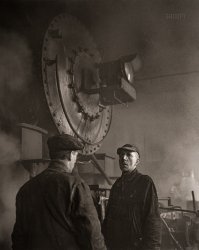
- The Summit: 1961
- ... (in 1963), for some reason, the company put me here one night. I flew in from Houston and took Carey in, and then somehow got to this ... Posted by Dave - 02/28/2013 - 1:55pm -
![The Summit: 1961 Sept. 18, 1961. New York. "Summit Hotel, 51st Street and Lexington Avenue. Exterior from northwest. Morris Lapidus, Harle & Liebman, architects." Hints of Cold War intrigue here. Gottscho-Schleisner photo. View full size.
Same sign, lesser impactThe vertical "Summit" sign pictured with such groovy shadows shrieks 1961 all by itself. Somehow, today's "Double Tree" use of the same sign just isn't as cool, or as classic.
The Promise of the Future!Its buildings like this that fueled my desire to become an architect - I'm so glad that it looks very close to the way it did when it was built.
UN Secretary-General Your comments got my attention, so I noticed the flags are at half-mast. I looked up the date and found that September 18, 1961 was the day that U.N. Secretary-General Dag Hammarskjöld died in a plane crash in Africa.
Out of placeI don't think it's ugly, but it's always seemed strangely out of place in Manhattan. Belongs in the suburbs, maybe. But it's supposed to be a very good hotel.
Still looks groovy!View Larger Map
Still groovy, indeed!And only about half a dozen blocks from Frank Lloyd Wright's Mercedes Benz showroom on Park Avenue, with its Guggenheim-like ramp.
This was my old subway stop (until the magazine moved to Soho) -- some fantastic terrazzo flooring still extant.
Carpe Diem!I like the way the Beverly Hotel (which I assume is the building next door) hits potential customers in the eye with a BIG WALL AD, trying to lure tourists and visitors away from the Summit with AC, TV, terraced suites etc.
Ugly Across the DecadesIt was ugly then and it's ugly now. I DO like the sign, however.
Landmarked in 2005The NYC Landmarks Preservation Commission report .
Shorpy Rule ComplianceThe hotel in this photo is in compliance with the Shorpy person-in-window rule. Level to a T.
Also a host to democracy When I lived nearby in the early 2000s my voting place was in this hotel, in one of the meeting rooms. There were not that many full-time residents in this commercial and hotel district, and many of those who did reside in the area were not U.S. citizens (in large measure because of the proximity of the U.N.), so even though it was right in the middle of bustling midtown Manhattan it was a very lonely polling place.
The hotel staff were largely unaware, and surprised to hear, that there was a polling place in their building. And the poll workers were genuinely happy to have anyone at all come in to vote. There was definitely no wait for a voting machine.
Flags are at half mast, why?the flags here appear to be hung at half mast. Searching the date on wikipedia does not reveal why. Anyone?
[The first comment submitted gives the likely explanation. - tterrace]
Such memoriesWhen I interviewed for my first job in Manhattan (in 1963), for some reason, the company put me here one night. I flew in from Houston and took Carey in, and then somehow got to this place. I was gobsmacked!!!! Such luxury and so au courant! Yes, I took the job!
Loew's LexingtonThe imprint of the old Loew's Lexington theater is visible (to the right) up to the sixth floor of what is now the Benjamin Hotel.
(The Gallery, Gottscho-Schleisner, NYC)](https://www.shorpy.com/files/images/SHORPY_5a28168u.thumbnail.jpg)
- Ready for Takeoff: 1912
- ...
Orders were issued from the War Department last night which, for the first time in the history of the army, will mobilize a ... Park and the Washington barracks all winter, left last night for Galveston to select a site for the station. A land station and ... Posted by Dave - 08/26/2012 - 11:44am -
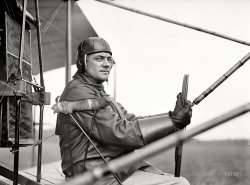
- A Hotpoint Christmas
- An appliance store at night. Christmas 1931. View full size.
Stocking Stuffers Nothing ... Posted by John.Debold - 11/07/2008 - 10:20pm -
![A Hotpoint Christmas An appliance store at night. Christmas 1931. View full size.
Stocking StuffersNothing says Merry Christmas quite like a new appliance! I'm sure that was tops on the list of every housewife in America in 1931.
WonderlandI'd love to walk into this picture (in perfect period dress of course!), and shop along that 1930s street!
I actually have cooked on a stove just like that one!
Advertising -- not always accurateIf you think giving "the little lady" appliances on Holiday occasions is a gift that "keeps giving," you're mistaken!
Steve Miller
"I do nothing productive. I'm in advertising."
Someplace near the crossroads of America
Awkward!The stove would be fine for righties, but not so great for us lefties. I'd be burning my stirring hand on the side of the oven.
However I'd much rather cook on it than one of the wood or coal powered stoves that are common in the Shorpy archives. The women (and men) who mastered those have my admiration.
How late are they open?Can we go inside, please? I just want to look around!
Window DressingThis store doesn't look very big or important, but look at the effort that has gone into those decorations. The house is quite amazing as are those glitter covered signs. Everthing would have been handmade and remember, this is before plastics.
[There were plastics aplenty in 1930. Cellophane, Bakelite, styrene, etc. - Dave]
Where is the Hotpoint store?Does anyone know where this is? I am surprised it isn't noted in the caption.
Hotpoint is great.But I think the shopper should also take a look at some Norge, Kelvinator or Tappin products...I have a 1952 Chambers Model 90-C stove that still works great...even cooks "with the gas off"--now that's impressive.
Surprised at youI thought you only showed socially useful pictures from the depression years. Hmpf! Tool of the bourgeoisie that you are, you'll probably be posting pictures of shiny new V-8 Fords and Moderne interiors before long...
ClockThat triangular chrome clock on the stove is the TM-8 designed by Ray Patten. It's interesting because GE owned Hotpoint and all GE's clocks were made by Telechron but not this one.
(ShorpyBlog, Member Gallery, Kitchens etc., Stores & Markets)](https://www.shorpy.com/files/images/Hotpoint0001_0.thumbnail.jpg)
- Gasoline Alley: 1926
- ...
Hits Home It is early evening. It is a Friday night. I am still at work (alas) in an office that overlooks the corner of L ... Posted by Dave - 09/13/2011 - 2:37pm -
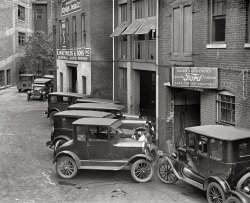
- Mo and Mammy: 1927
- ... was too sick to be told, her son, George Jolson, said last night.
The famed singer and comedian used to write home every week and Mrs. ... to Mom and Pop over and over again." George said last night. Robbi Yoelson died about five years ago.
Earlier in her life. Mrs. ... Posted by Dave - 08/27/2012 - 5:05pm -
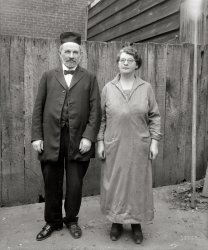
- El fotógrafo serio: 1978
- ... this Koadachrome slide, and I paid ₧3676 for our one-night double, or about $48 then. Today, the same accommodations seem to be ... or so before departure, staying up later and later each night watching old movies on TV and playing card and board games. It didn't ... Posted by tterrace - 09/29/2011 - 6:07pm -
![El fotógrafo serio: 1978 June 19, 1978. Apparently I hit the J.C. Penney men's department immediately before my trip to Spain. At any rate, here I am color-coordinated and looking inexplicably serious with my Nizo Super-8 movie camera at the parador Jarandilla de la Vera, Spain. My friend, who took this Koadachrome slide, and I paid ₧3676 for our one-night double, or about $48 then. Today, the same accommodations seem to be €166, or about $239. History does not record what Emperor Charles V paid when he stayed here in the 16th Century, nor what he watched on TV. No doubt he was better-dressed.
Now that I think about it, my expression may be the result of jet-lag; this was the day after we arrived. My friend and I tried to avoid it by gradually adjusting our sleep schedule to Europe time for a week or so before departure, staying up later and later each night watching old movies on TV and playing card and board games. It didn't really work. We did document it in a series of rather amusing photos, though. View full size.
ColorizationYou forgot to make the sky Sky Blue!
Recuerdos del emperador Carlos VCharles V may have had spiffier duds, tterrace, but he had nothing on you for camera coolness. Here he is with his Nizo Super-8, as documented (more or less) by his buddy Titian.
Jet LagAs I mentioned, this was taken the morning after our arrival in Spain. In our trip journal for the night preceding, my friend wrote "Retired early due to jet lag and sangria." So apparently I was I was depraved on account of I was deprived. Below is one of those allegedly humorous jet lag-avoidance photos, me in my robe and jammies at about 4AM in our living room in Larkspur, ready to crash.
1970's JC Penney wardrobeThat outfit is really something; it reminds me of my own wardrobe from the late 1970's. (Except mine might have been from Montgomery Ward.) If you want a real flashback, check out this 1977 JC Penney catalog
http://www.rense.com/general79/jcpenny.htm
NOTE: pay special attention to the subtitles that accompany the photos!
Now That You Mention ItYou do look like a victim of sleep depravation.
[So tterrace is sleep-depraved. - Dave]
He is according to to the caption he wrote. - Mal
[Depraved, or deprived? - Dave]](https://www.shorpy.com/files/images/fotographoserio.thumbnail.jpg)
- Playland: 1934
- ... Santa Clara Valley in the 70s, one of our favorite special night-out places to go was Cliff House. To sit next to the windows and look ... and then slide down onto the dance floor to dance away the night.
Some great images and story about the place here .
... Posted by Dave - 11/17/2015 - 2:17pm -
![Playland: 1934 An interesting look at San Francisco car culture circa 1934. "Ocean Beach Playland -- Red Bug and Cliff House on Great Highway." With a billboard advertising Topsy's Roost, a dancehall and fried-chicken emporium just out of frame to the right. 5x7 negative, formerly of the Wyland Stanley collection. View full size.
A TrunkThe two cars left front show why we call the compartment in the back of the car a "Trunk". It was just a natural migration from an add on to a part of the car.
But I still haven't figured out why the British call it a "Boot"...
Scary MasonryThe scaffolding on the hillside was a skeleton that would support fake rocks being constructed out of cement or some similar material. I believe these were added to control erosion of the hillside as a project of the CCC (Civilian Conservation Corps). In later years, as they began to deteriorate and holes opened in them, the fake rocks made a nice clubhouse for illicit teen activities. The rocks were an eyesore and a safety hazard when they were finally removed sometime in the '70s.
WaterfallActually, the piping visible at right in the photo once fed an artificial waterfall that flowed downhill alongside the mini-windmill.
The attached 1927 photo from the SF Public Library shows the waterfall in its free-flowing glory.
Also, National Park Service did indeed remove several large, hollow fake rocks along the cliff face in the late 1970s. I used to patrol there for the Park Service, and one never knew what they were about to encounter when they entered the intensely creepy interiors.
Boot-Trunk, Bonnet-HoodOur British cousins decided early on to define the various ends of a motor vehicle analogous to human clothing of the day. Hence "bonnet" became the "top" (front) and "boot" became the bottom (rear).
Being far more practical and much less flowery we Americans call ours the "hood" (over the engine, at least for most cars) and "trunk" (self-defining).
The Brits also got the driver's position on the wrong side but that's a whole 'nother discussion.
Scaffolding to build the faux rock facadeI've climbed these cliffs a lot. The fake rocks are still there.
https://goo.gl/maps/vC5Jtj2ikKB2
I'm pretty sure that was a workmen's scaffolding to build them.
\
The closer cliff has been covered with ferro-cement and the pipes on the right seem to be connected to some sort of water feature that is still visible today as
pools, cascades, and fonts when it rains.
By 1938 the whole area was commandeered by the Coastal Command and next to the parapet at the top there still stands an OP pillbox.
I'll pass on the half fried chicken. I want my chicken fried completely.
Seal Rocks IslandThe building next to the sign in Shorpys picture is very similar to the one in the attached picture.
[There was no picture attached, but the building at the left edge is the most recent Cliff House, built in 1909 and today restored to its original appearance. -tterrace]
ROAD TRIP!To the Cliff House of the 1970s. I want the crab salad, an order of onion rings, and two of the tequila sunrises.
Lasergirlnm is buying. Thanks!!!
Boots and allA boot was a term used for a luggage compartment on a stage coach so it looks as though the English usage was just a continuation of the term from horse drawn to motorised. I suspect that an English person from the late 19th/early 20th centuries would think of a trunk as something to go in the boot.
StyleNowadays we hear people say that cars all look the same. After looking at this picture, cars today all have like styling just as the cars in this picture do. Just as most four door, two door and hatch type models today share like design, there's three distinct styles of cars in this photo that are all very similar too.
Cliff House!When I lived in the Santa Clara Valley in the 70s, one of our favorite special night-out places to go was Cliff House. To sit next to the windows and look out over the ocean without seeing anything else but water was scary and fascinating at the same time. They had a crab salad on the menu that took up a seashell-shaped bowl that was the size of a lavatory! And they had THE best tequila sunrises ever at Sunday brunch. Sometimes I wish I could go back to those days.
My grandfather used to work at Topsy's Roost. He was a sous chef there until opening up his own restaurants. That was a wild place. People would sit in their "roosts" and then slide down onto the dance floor to dance away the night.
Some great images and story about the place here.
Cruising StripNote how there are four cars making U-turns here to head back southward on the Great Highway. Either they were looking for parking at Playland or they were out enjoying the weekend cruising strip along the beach.
(The Gallery, Cars, Trucks, Buses, San Francisco, W. Stanley)](https://www.shorpy.com/files/images/SHORPY-776.thumbnail.jpg)
- Street Arabs: 1888
- ... staged to me.
Longfellow The Day Is Done And the night shall be filled with music,
And the cares, that infest the day,
Shall ... Posted by Dave - 02/03/2019 - 7:12pm -
![Street Arabs: 1888 New York circa 1888. "Street Arabs in 'sleeping quarters'." Photo by the Danish-American social reformer Jacob Riis (1849-1914). View full size.
How the other half poses. Poorly. The kid on the left is peeking. I'm sure of it.
I believe the young man is dreamigProbably of a nice hot meal and a clean bed.
Sleeping boysSeems to me, that this picture is posed. Look at the smiling face of the left kid. But maybe I'm not right - maybe he's dreaming about warm, clean, cosy bed and pajamas?
The Gilded AgeMr. Vanderbilt, Mr. Morgan, Mr. Rockefeller, Mr. Carnegie -- anyone?
Forty wink-winksSure, those three young fellows really fell asleep like that. And there's some oceanfront property in Nebraska you need to check out before it's all gone.
Forty wink-winksSure, those three young fellows really fell asleep like that. And there's some oceanfront property in Nebraska that you need to check out before it's all gone.
Two-way streetI wonder which way it went in popular lingo: From street arab to street urchin or vice-versa?
Nomads Without the CamelsSo Google tells me "Street Arab" is a now archaic way of saying homeless street kid. I had no idea. I bet there was story behind that term, when it was in use.
NewsiesThe way these streets urchins survived was to sell newspapers, go through garbage, and even pick up dog feces. The latter was sold to local tanneries. I had a cousin who did this to survive. He became successful accountant.
Look at the eyesYou can fall asleep in some of the weirdest places, and I certainly have, but looking at the eyelids, it looks like there is some tension in the forehead that suggests they're squeezing them shut for the picture. I also notice that their cheeks are filled out nicely, as if they're at least somehow getting enough to eat, their hands show evidence of work and dirt, and their hair looks combed. I'm guessing they're actually tenement residents whose parents send them out to beg/whatever.
Maybe the photographer took them out for a bite to eat afterwards. I hope he did.
What's Real?The clothes, holes and dirt don't look staged to me.
Longfellow The Day Is DoneAnd the night shall be filled with music,
And the cares, that infest the day,
Shall fold their tents, like the Arabs,
And as silently steal away.
James Thurber's mother remembered it as "like the Airedales."
A-RabBaltimore once had itinerant street merchants, most with horse and wagon, whom the locals called A-Rabs. They did everything from sell produce to collect rags and scrap, but the term was pronounced with a long A.
No doubt an adaptation of the term used in this photo, though I can only guess at the etymology … perhaps the crowds of mendicant children one could observe in the cities of North Africa in former days?
[They're "Arabs" because they're nomadic, wandering from place to place. - Dave]
(The Gallery, Kids, NYC)](https://www.shorpy.com/files/images/SHORPY-00037u.thumbnail.jpg)
- Egg Rollers: 1911
- ... conditions today, issued by the weather bureau last night at 11 o'clock are: Fair, slightly warmer Monday.
Easter Finery ... Posted by Dave - 08/23/2012 - 6:17pm -
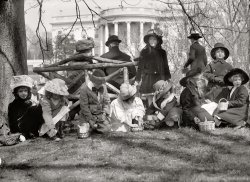
- Neither Snow Nor Rain: 1900
- ... famous motto "Neither snow nor rain nor heat nor gloom of night stays these couriers from the swift completion of their appointed rounds" ... Posted by Dave - 08/01/2012 - 5:46pm -
![Neither Snow Nor Rain: 1900 Circa 1912. "Post Office, New York City." Although it looks about a million years old, the Eighth Avenue post office is still under construction in this view. Enlarged in 1934, it's now called the James Farley Building and has the zip code 10001. The famous motto "Neither snow nor rain nor heat nor gloom of night stays these couriers from the swift completion of their appointed rounds" is inscribed on the entablature. 8x10 inch glass negative, Detroit Publishing Co. View full size.
+99Not quite the same angle, but the Farley Building is still going strong.
Soon to be the New Penn StationThe Post Office was designed by McKim, Mead and White to complement the old Penn Station, located just across the street (Eighth Avenue). MM&W also designed the very elegant lampposts that stood around both buildings. In a singular twist of fate, the Post Office is slated to be transformed into the newest version of Penn Station, to be called Moynihan Station in honor of the late Senator from New York. The main entrances will be located on the side streets midway down the block at street level, not on the front facade, so the passengers of the future will not be forced to lug their bags up that impressive flight of steps.
From Pennsylvania StationThe view is looking northwest across Eighth Avenue from Penn Station, where trains from New Jersey entered via tunnels under the Post Office. You can still see the Post Office "yard" where the mail cars were accessed under the Post Office Building, in the ancient daze of old.
The inside is just as impressive.
Those Were the DaysIt was good to be the P.O. back then but no longer. Can you say "email"?
Sign Of The TimesIf the US Postal Service stays the course, there'll soon be condominium space available in this building.
LettersI read that this is the longest inscription on any building in the world.
Light polesWhat beautiful light poles and fixtures now replaced with the incredibly ugly 34th Street Partnership poles.
Almost the samePretty much the same angle though not quite the elevation. She hasn't changed much in the decades.
In the ShotI assume in the lower left corner is the roof edge of the neighboring building serving as the photographer's vantage point. I don't recall seeing this kind of context often in these types of photos. At first glance I thought I was looking at 31st Street dug up for pipe laying!
Private Dick"That guy on the corner's been shadowing me all day!"
What kind of tracks?There aren't any catenary lines overhead to power electric street cars so the tracks are somewhat interesting. Upon close inspection, it looks as if there is a middle slot between the tracks which would indicate that cable cars (much like the ones still in San Francisco) once passed in front of this building.
New Your, surprisingly, did have cable cars back in "the day," but I wasn't aware that they extended this far north into Midtown.
[These are electric streetcar tracks with access to the power supply via the central slot. - Dave]
(The Gallery, DPC, NYC)](https://www.shorpy.com/files/images/4a24669a.thumbnail.jpg)
- Hires Root Beer: 1904
- ... Larger Map
What a great evening An enjoyable night of entertainment it would have been. A Hires Root Beer in hand while ... Posted by Dave - 07/19/2012 - 1:00pm -
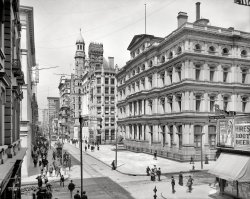
- Smokeboat: 1918
- ... William H. Callahan, traffic manager of the company, last night. "We consider it mysterious," he said, "because the fire originated in a ... business."
The fire was discovered by C.O. Abbott, night watchman, and clerk of the company. He said he was sitting in his office ... Posted by Dave - 09/14/2011 - 3:37pm -
![Smokeboat: 1918 September 1918. "Norfolk & Washington Steamboat Co. fire at Washington docks." National Photo Company Collection glass negative. View full size.
You all have it wrongIt's supposed to look like that. It's the Smoking Lounge. LITERALLY.
A little dustingA bit of sweeping and it will look as good as new.
BedframesJudging by the number of bedframes, this ship must have offered overnight accommodations - rather than just simple ferry service across the Chesapeake Bay. Since ships are usually near a ready supply of water, a sprinkler system would have been worthwhile.
ButtsWas this a case of smoking in bed?
Bad luckThis was the N&W steamboat NEWPORT NEWS, built in 1895.
"Burned at Washington September [2,] 1918. Rebuilt at Baltimore and renamed Norfolk & Washington Steamboat Co. 'Midland' on November 11, 1919".
Steamboat MIDLAND. "Rebuilt from old Norfolk & Washington Steamboat Company 'Newport News' in 1919 after burning of September 1918. Burned and lost at Washington in March 1924".
[Google Books: Richard E. Prince, Seaboard Air Line Railway. Steam boats, locomotives, and history.]
Mysterious Steamer Blaze
Washington Post, Sep 3, 1918.
Dock and Steamer Blaze Mysterious
Officials of Norfolk & Washington Co. Puzzled by Fire.
Officials of the Norfolk and Washington Steamboat Company are endeavoring to ascertain the origin of the mysterious fire which early yesterday badly damaged the steamer Newport News and destroyed the company's general offices, warehouse and dock and which for a time threatened the entire water front.
"All we know about the fire is that it started in the linen room of the offices, and resulted in the loss of about $125,000," said William H. Callahan, traffic manager of the company, last night. "We consider it mysterious," he said, "because the fire originated in a part of the office where it could least be expected. The Newport News is our emergency ship, and is only used when either the Southland or Northland is out of commission. It could have been possible for some one to have intentionally set the office on fire, but I doubt if that was the case.
The Newport News had been docked for some time, and there practically was no freight no board. The vital parts of the vessel are intact, and just as soon as we can secure the necessary labor, reconstruction work will begin. There will be no interruption of the passenger business."
The fire was discovered by C.O. Abbott, night watchman, and clerk of the company. He said he was sitting in his office about 3:30 o'clock, when he smelled smoke, and walking to the back part of the building, discovered the flames pouring out of the linen room. He immediately turned in an alarm, but before the engines arrived, the whole building and the Newport News were on fire. A general alarm was sounded, and the firemen had great difficulty in extinguishing the blaze.
Among the destroyed and damaged freight on the dock were several chasses, two automobiles, two airplane engines, bed springs and mattresses, thousands of bottles of soft drinks, 100 sacks of peanuts, fourteen barrels of tar, two marine engines and several tanks of carbonated water.
All records of the company were locked in metal cases and were saved. Fifty barrels of oil, 75 barrels of tar and other government stores on the dock, awaiting shipment to the naval operating base at Hampton Roads, Va., were not damaged. The company's loss is entirely covered by insurance.
The American Marine Engineer, September, 1918.
Atlantic Coast Notes
The work of raising and restoring the steamer Newport News, of the Norfolk and Washington Steamboat Company, which burned at her dock in Washington a short time ago, has been undertaken by the Merrit and Chapman Wrecking Company. It is stated that the hull and machinery are practically undamaged, but the entire super structure will have to be rebuilt. The steamer had been used as a reserve boat, and therefore, the loss to the traveling public is not great.
InflationNow let me get this straight: the damage to the ship we see in the photo, plus that described in the contemporary article in the office building, warehouse, and dock, including customer cargoes awaiting shipment, is all going to be set right by only $125,000?
Is there any way I can get some of those 1918 dollars? Sigh. No, I guess not.
I'm SorryI’m afraid that this may void your warranty.
(The Gallery, Boats & Bridges, D.C., Natl Photo)](https://www.shorpy.com/files/images/30621u.thumbnail.jpg)
- American Bandstand: 1959
- ... Dick Clark, who I'm sure was emcee of a heavenly show last night.
And to Shorpy, Dave and ALL readers of this blog!
Peace! ... Posted by Dave - 12/31/2013 - 10:56pm -
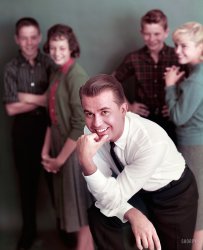
- Chester Park: 1906
- ... were held here throughout the summer months and even at night. A famous contest in the 1890s called the Poorman Road Race began in ... Posted by Dave - 08/05/2012 - 4:22pm -
![Chester Park: 1906 Cincinnati, Ohio, circa 1906. "Lake and clubhouse, Chester Park." 8x10 inch dry plate glass negative, Detroit Publishing Company. View full size.
High wire actI wonder how the wagon-wheel looking thing figured in all this.
What a great day for walk!Life is being on the wire; everything else is just waiting
No longer thereSome interesting details about the park and its history:
"The park was in Winton Place on the north side of Spring Grove Avenue near Mitchell Avenue, opposite the Winton Place railroad station."
View Larger Map
Twirling sparklersCould the "wagon wheel" have been a fireworks set-piece? Clearly, it can be lowered to the water level, and raised to just below the wire. If lances were installed on the angled sticks, it would probably rotate slowly, shooting fountains of sparks up and over the highwire artist.
Lots o'LightsThere is a spotlight on the upper balcony. Probably to shine on the evening performance of the high wire act?
And most of the telephone poles have globe lights that can be raised and lowered via pulleys. Maybe they were lowered at dusk to be lighted (gas lamps, you know) and then raised above the heads of the spectators to help light their way along the boardwalk after dark.
[Those globes hanging from the poles are carbon-arc (electric) lamps. - Dave]
Artistic licenseI wonder they somebody (photographer) drew over that one cable that crosses the frame. If he was trying to hide it, well, the pure black shows up more than if it were left alone. Or was that a physical crack in the plate?
[The negative is broken in two. Which is why the ropes don't quite line up. - Dave]
TodayBeautiful, thank you. I live in this Cincinnati neighborhood -- now called Spring Grove Village -- and there is no trace left of Chester Park.
Chester Park VelodromeIn my research on the early history of bicycling in Cincinnati I've come across a number of references to Chester Park. To the outside of the rail track was a quarter-mile cinder sprinting track and outside of that was a third-mile cement bicycle track. Races were held here throughout the summer months and even at night. A famous contest in the 1890s called the Poorman Road Race began in Hamilton Ohio and finished at the track. The clubhouse you see housed bicycle rooms, shower facilities, and athlete changing rooms.
(The Gallery, Cincinnati Photos, DPC, Railroads)](https://www.shorpy.com/files/images/4a13520a.thumbnail.jpg)
- Mystic Manor: 1940
- ... on the negatives are in chronological order, the election night photo was taken before the house photo. -Dave]
Another HOF-worthy ... Posted by Dave - 01/15/2019 - 12:07am -
![Mystic Manor: 1940 November 1940. "House, late afternoon. Mystic, Connecticut." Also a late-afternoon moon. Medium format negative by Jack Delano. View full size.
CreeeeepyAm I the only one who thinks houses with mansard roofs are creepy?
Undoubtedly Lurch will open the door and usher you in for your appointment with Sweeney Todd.
The Mansard FamilyMany people are not aware that Jack Delano took a few pictures of the interior of this house. Example below.
Your talents aren't wastedMystic Manor - I'm sure that a contractor somewhere will plagiarize this to name their next housing edition (or nursing home), Dave. If not, you have a new naming career ahead of you.
I Can't Find It -- Darn ItAs usual, I spent too much time trying to find this beauty, which strikes me as an unlikely teardown. But there are some hints I can leave for someone with better skills.
1. Delano took another picture of the house that is here:
http://www.loc.gov/pictures/item/2017792588/resource/
2. That picture (also taken in late afternoon) shows a partially commercial street that is near the town's river. It is also likely the house faces west or southwest, based on time of day, and the position of the shadows.
3. The address is 25 ????? If it's Willow Street (my best guess), Google Street View doesn't go there.
OMG!Is that Anthony Perkins' "Mother" in the second floor window?
When a 60 year old house looked "old"Unlike today when many houses 50-60 years old still have a modern or contemporary look, in 1940 a house from probably the 1880's really looked old compared to what was modern by that time so quickly were architectural styles changing. It also bears a vague similarity to what's called the Psycho House which is in reality a backlot stage set.
Found it! Broadway Avenue between Main and Washington.
Alas, this house didn't survive - it's a CVS parking lot. The key clue was the gas station across the street - once they go in, they RARELY come out. The porch on the house next door has been filled in, but the brackets at the eaves are unmistakable. The signpost in front of the tree is likely directing drivers down Route 1 toward Stonington, Westerly and ???. Naturally, the grand house is gone but that little bungalow across the railroad tracks (with the gable facing us) still stands.
I think I found the lot, but the house is goneFirst I found another photo from the area by Delano; had to magnify significantly to locate the house at the "end" of the road, behind a statue in the middle of an intersection. Then I found the statue on Google maps, and noted that 25 Broadway is the address of a CVS store, which is just behind the statue when viewed from the church.
http://www.loc.gov/pictures/resource/fsac.1a33860/
Shorpy members come through againMore fine sleuthing by the Shorpy brain trust in locating the site of the house.
Using the moon phase in the photo, I'll bet Neil deGrasse Tyson would be able to determine the day in November 1940 the photograph was taken.
Gone shortly after?According to Historic Aerials, the structure that was there in 1934 was gone by the next photographic record in 1957.
A shame, that was quite a house!
The Morgan HouseLooks like progress did this house in in the 1940s or '50s:
http://www.mystichistory.org/collectionsexhibit/vex1/6B184218-252A-4D19-...
A number of pictures (circa 1930) of the house in winter at this site.
http://www.mystichistory.org/collectionsexhibit/vex1/toc.htm
Neil deGrasse Tyson Not NeededBased on the moon phase the date is probably the 7th or 8th of November 1940. The house faces west and has late afternoon sunlight. The moon in the image is in the southeastern sky. I determined the approximate date from the moon phase shown on this website.
https://www.calendar-12.com/moon_calendar/1940/november
[Excellent sleuthing. Two frames away from this photo of the house (a sequence that can be found here) is an image of "crowd listening to election returns" for the 1940 presidential election, which was held on November 5. If the numbers written on the negatives are in chronological order, the election night photo was taken before the house photo. -Dave]
Another HOF-worthy threadThe thoughtful posts on this photo are hall of fame-worthy.
It's hard to overstate the sense of collaboration and community fostered by Shorpy's moderators and readers. Everyone's unselfish sharing of knowledge, sleuthing hints, and resources is a fine thing.
Edward Hopper was addicted to theseHe painted dozens of houses like this one.
(The Gallery, Jack Delano)](https://www.shorpy.com/files/images/SHORPY-8c03790a.thumbnail.jpg)
- Tommy Atkins: 1905
- ... knew he was in the war and he was a man of few words. One night at the pub he did speak of his time there. I asked what it was like. ... Posted by Dave - 06/26/2018 - 6:19pm -
![Tommy Atkins: 1905 Circa 1905. "Tommy Atkins." The name being a sort of generic, John-Doe-type moniker for a British soldier. (Yes, I had to look it up in Wikipedia.) 8x10 inch silver gelatin glass transparency, Detroit Publishing Company. View full size.
Ol' Tommy AtkinsThought I'd let you know what kinda pal Ol' Tommy Atkins was ...
Everybody knew he was in the war and he was a man of few words. One night at the pub he did speak of his time there. I asked what it was like. All he said, with a tear in his eye was: "Rough. Rough. Rough."
Tommy Atkins was the kinda pal that would a give you his left paw if you asked 'im to!
Tommy Atkins was the kinda pal that was always there. If you asked 'im to come, he came.
His daddy may have been a dog. And his momma sure was a bi___, but that Tommy Atkins was the best friend a guy could ever had.
Tommy Atkins?No, that's Churchill!
TommyThen you didn't remember your Kipling, Dave!!
"O it's Tommy this, an' Tommy that, an' "Tommy, go away";
But it's "Thank you, Mister Atkins", when the band begins to play,
The band begins to play, my boys, the band begins to play,
O it's "Thank you, Mister Atkins", when the band begins to play"
[Not only do I not remember my Kipling, I never Kippled to begin with. - Dave]
I Know Him!I saw him in a painting, playing poker with a bunch of other dogs.
Two BulldogsBeing a pipe smoker for many years my first reaction to this great picture was "Wow, a bulldog with a bulldog".
What?He's not playing cards with a few other dogs in a rec-room and swilling beer?
(The Gallery, Bizarre, Dogs, DPC)](https://www.shorpy.com/files/images/4a30411a.thumbnail.jpg)
- The Whip: 1928
- ... amusement grounds, formally opened the 1918 season last night. More than 10,000 persons, including the "tired business man" and the ... the evening in the park.
The center of attraction last night was the new "Whip," the Coney Island sensation which has just been ... Posted by Dave - 07/24/2008 - 3:33pm -
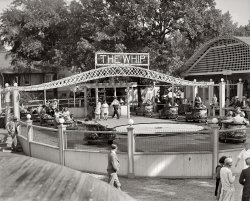
- Men's Grill: 1940
- ... as well. She didn't take the public elevators. But one night, when I had to work late I had to take the freight elevator down — and ... in the elevator and acted as if she was just another late night office worker.
At one point, earlier in its history, the Cuban ... Posted by Dave - 03/14/2016 - 10:01am -
![Men's Grill: 1940 December 1, 1940. "Schrafft's, 625 Madison Avenue, New York. Exterior." 5x7 inch acetate negative by Gottscho-Schleisner. View full size.
Classy Joint!Marble frontage, revolving door, drapes over the windows, lights above and behind the 3D signwriting, logo set into the poured marble chip entrance, neat net curtains above, professional window dressing . . .
No dames allowed!What is a Men's Grill? Is that a fancy phrase for a bar? If so, it seems that women would have been both welcome and comfortable there by 1940.
[A bar, yes. Schrafft's had a reputation as a "women's restaurant" and tried to expand its clientele with such measures. - Dave]
Upon ReflectionHide though he might try, the photographer and part of his tripod can be seen behind the lady in white, all the way to the left.
In the upper right, the reflection of a residential apartment building across the street on Madison Avenue in the 50's in the 40's is a surprise.
Deep, dark and wetTragedy struck this fine watering hole in '48
Re: Men's GrillI'm not sure, but it could be that in reference to the "Men's Grill", it meant just that. In many places (although as far as I know, New York City was Not one of them), proper ladies didn't go into a bar, but were served at a table. This Grill might have been for men only.
[You could order a steak, yes, but there wouldn't have been any men in the Men's Grill without the bar. - Dave]
Ah, Lunch!As a young boy in the 1950s, I would often accompany Mom on shopping excursions to NYC (Macy's, Gimbels, Bloomingdale's etc).
Lunch at Schrafft's was my reward for hours of walking up and down the endless aisles.
We never left without a box of candy!
Re: Upon ReflectionSamuel Gottscho: the master at work (1950-1956).
I've worked in this building...This is the old Standard Brands building on Madison Avenue in NYC. I worked there from 1977 to 1981 as a copywriter at Compton Advertising. During that time, Jackie Onassis worked as an editor for the Viking Press, which had their offices in the building as well. She didn't take the public elevators. But one night, when I had to work late I had to take the freight elevator down — and when the door opened, there she was. And like any New Yorker, I got in the elevator and acted as if she was just another late night office worker.
At one point, earlier in its history, the Cuban consulate was in the building so that there were always police on guard outside.
I still go into the building a couple of times a year because one of my doctors has offices there. The building has been re-skinned and renovated inside, but retains its mid-century charm.
Super Marketing!For the men who imbibe too much they have at the ready candy and other sweets for the sweet to bring home for the late arrival.
(The Gallery, Eateries & Bars, Gottscho-Schleisner, NYC)](https://www.shorpy.com/files/images/SHORPY-5a05980u.thumbnail.jpg)
- Father Duffy: 1937
- ... Planters I would love to have seen the Planters sign at night - lit up in its glory!
+76 Another photo of Father Duffy I took ... Posted by Dave - 07/27/2013 - 1:17pm -
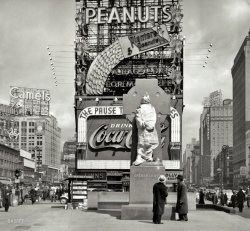
- Bottle Boy: 1909
- ... in the glass works for two years, and has worked some at night." Photo and caption by Lewis Wickes Hine for the National Child Labor ... Posted by Dave - 05/17/2014 - 11:39pm -
![Bottle Boy: 1909 November 1909. Wheaton Glass Works, Millville, N.J. "Day scene in New Jersey Glass House. Boy is Howard ____, 15 years old but has been in the glass works for two years, and has worked some at night." Photo and caption by Lewis Wickes Hine for the National Child Labor Committee. View full size.
Child laborIts amazing how many kids Hines photographed back then. I always wonder what he DIDN'T take a picture of.
Had any of you been a child worker back then, do you think you would have grown up to despise the company, or grown up to be proud of what you accomplished at such a young age?
Here is the story of a 9 year old boy that started working at the Hemingray Glass Co. in 1869, after his father died.
His employment with them went on to last over 70 years.
Paneful IronyA glass factory with no visible windows. That is so ironic but seems cruel for these kids!
I must say I'm surprised at the shabby working conditions. I know Wheaton Glass, and assumed their workers worked in lovely light filled conditions. What a surprise.
Looks like a nice healthy enviroment.Are those sheets of Asbestos one the table in front of that kid?
Antique Wheaton Glass is highly collectible.Perhaps every antique Wheaton bottle sold should come with a copy of the Lewis Hines' series of photopgraphs taken at the factory.
Wheaton Glass is still in existence today, specializing in lab and scientific glassware, as well as bottles for all purposes.It has been one of the primary employers of the southern New Jersey region for decades. I had a good friend who worked summers during college at the Wheaton factory. He described it as potentially dangerous work, performed under blisteringly hot conditions. This was during the mid-1970s, when Wheaton was trying to meet OSHA standards that had just been introduced in the previous four or five years. He told me that the factory "old-timers' had plenty of horror stories about lung diseases and accidental burns that safety regulations in the workplace had helped to curb.
Bottle Boy: 1909This is Joe Manning, of the Lewis Hine Project. According to the 1910 US Census, there were four boys named Howard living in Millville who were about 16 years old and who worked in a glass factory. They were Howard Lee, Howard Facemire, Howard Atkinson, and Howard Sharpless (good name for a glass worker). So which Howard was this boy? According
to an unidentified researcher who posted a comment on the National Archives website, the boy was Howard Lee. I'll see what I can find.
For an excellent storyFor an excellent story that deals, in part, with the life of a boy in a glass factory in the early 1900s (as well as a Lewis Hine picture on the jacket!), I recommend "Billy Creekmore by Tracey Porter.
Trivia: Most of the character in the book were named after real kids who killed in mining, factory, and mill accidents.
Interestingly, I have never been able to find the Lewis Hine jacket picture in any online collection.
Regular shoes?As I was told during a guided tour through a glass works in the Black Forest (Germany), glassblowers are just about the only workers actually required by work safety standards to use slippers.
Rationale is to get the foot out of the shoe PDQ if some of the melt (up to 1500 Centigrades or 2700 Fahrenheit) should drop from the blowpipe on the shoe. So they slog around in very fashionable slippers. Including steel caps - they are working shoes after all.
Another occupational hazardWhen I collected bottles as a kid, I remember reading an interview with a guy who had worked in a bottle factory in Jersey about the same time as this boy [and probably about the same age as well]. He said that after a number of years you could tell veteran glass blowers because "their cheeks hung down like sacks".
He went on to add that the introduction of the automatic bottle machine in 1903 eliminated that problem.
(The Gallery, Factories, Kids, Lewis Hine)](https://www.shorpy.com/files/images/SHORPY_05447u.thumbnail.jpg)
- Steeplechase for Fun: 1904
- ... Musical & Scenic Railway" roller coaster ("Day & Night in the Alps"), an observation tower advertising Steeplechase Park and, at ... Posted by Dave - 05/17/2014 - 10:43pm -
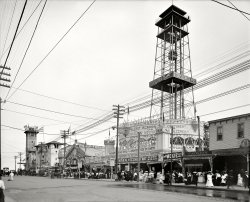
- Mammoth Plates: 1891
- ... Glass plates were coated on the spot. Or at least the night before. The glass was the expensive part, the silver nitrate emulsion ... Posted by Dave - 08/13/2012 - 7:56pm -
![Mammoth Plates: 1891 Mexico circa 1891. "Ferrocarill Central Mexicano. Canal of Nochistongo," a drainage excavated in the 17th and 18th centuries to keep Mexico City from flooding. Note the giant camera and tripod employed by William Henry Jackson in the making of his heroically proportioned photographs, the largest of which were recorded on a medium the archivists call "mammoth plates" -- glass negatives that measured 18 by 22 inches. (This particular image was made on an 8x10 inch glass plate -- what modern photographers would consider "large format," but still only a fifth the size of an 18x22.) Detroit Publishing Co. glass negative. View full size.
Big CamerasWere those "Mammoth Plate" cameras custom or home made or were they available commercially?
ImpressiveI used to shoot a lot of landscapes in large format (4x5) before the digital age hit photography. I can identify with these gents lugging all that equipment around but not to the extent they did. I cannot imagine 18x22 in the field. My hat's off to them. That's an extremely hard thing to do.
Unsteady footingOne slip, and goodbye large format camera, tripod and photographer!
PerspectiveIs anyone fooled by the perspective here? It doesn't look like that ledge is tall enough for the train to look as tiny as it does!
The Big Picture>> Were those "Mammoth Plate" cameras custom or home made or were they available commercially?
If you were a photographer in the mid 19th century you'd most likely buy a prefab lens assembly and make the box yourself (not that complicated, as most cameras then didn't have shutters), or have one made to your specification. After the Civil War, American Optical, Scovill and the Henry Clay Co. were among the commercial makers of big view and box cameras. A nice selection here.
Rapido corren los carrosMakes me think of a rolling "rrrrrr" tongue-twister a Mexican priest taught me many years ago: "Rapido corren los carros cargados de azucar de los ferrocarriles."
Glass PlatesGlass plates were coated on the spot. Or at least the night before. The glass was the expensive part, the silver nitrate emulsion came in either screw top tins or light tight jars, and were coated in the field. If the plate negative was not satisfactory it was a simple matter to strip the emulsion, recoat the glass plate and try again.
[You're thinking of the wet-plate negatives used around the time of the Civil War. Most glass plates made after 1880 (including this one) are dry-plate negatives -- coated with emulsion by the manufacturer and presensitized. - Dave]
Little Town in the backgroundI like how you can make out the little town in the background of the photo. You can see the big church with its dome and towers.
Very nice picture. I wonder where in Mexico this was taken.
Nochistongo CutThe little town in the background distance of the photo is Huehuetoca, State of Mexico. The domed church that you can see in the distance is still there and can be located near the center of town on google maps. This impressive ditch called the Nochistongo Cut (El Tajo de Nochistongo) was dug by hand (mostly indigenous near slaves) starting, if I recall correctly, in about 1607 and took about 120 years to complete. It is said that up to 30,000 laborers were worked to death in the process, though I haven’t seen any historical texts confirming it. Considering the times & place it could easily be true. It’s about 45 miles from Mexico City and is visible (the ditch) in satellite view though the waterway is obscured by trees & bushes. The railroad still passes there but there are 4 lines now. The area is rapidly filling up with outer suburbs of the capital. It was dug in an effort to relieve the severe flooding Mexico City was subject to ever since the Spanish conquest, when the Spaniards as a tactic destroyed some of the protective dikes the Aztecs and their precursors had erected to regulate water flow in the Valley of Mexico and then proceeded to erect their own capital city on the ruins. Ultimately the cut was not successful at stopping the flooding, as Mexico City was sinking slowly into the mud of the ancient lake beds, leaving the drainage collectors too high to drain all of the low areas of the city.
(The Gallery, DPC, Railroads, W.H. Jackson)](https://www.shorpy.com/files/images/4a03443a.thumbnail.jpg)
- Joy Boys: 1940
- ... the bar is in looks like a barracks.
I'll bet at night the neon looked really cool.
Who dunnit? LOC says these Starke ... Posted by Dave - 08/05/2020 - 2:22pm -
![Joy Boys: 1940 December 1940. Starke, Florida. "Soldiers Joy Cafe, newly constructed for construction workers near Camp Blanding." Acetate negative by Marion Post Wolcott. View full size.
It seems the wardid not stifle the production of beer or neon signs.
Three fellowswaiting for a novel to be written about them.
The middle guy and one on the viewer's left look like they could be related. Brothers? But the fellow in the coat and hat --
I bet they all told interesting stories when they were drunk.
Does it really get cold enough in Florida for a coat that heavy?
[Oh my yes. - Dave]
Native Floridian at a glanceStarke is in northern Florida and this image was made in December so to a native of the state the weather is very cold. To those new in town it is Florida and 60 degrees is plenty warm -- all we need are sleeves and maybe a light sweater.
It is even more obvious in South Florida when picking out Canadians versus natives at the pool in January. Canadians dive in when natives hesitate to dip a toe.
Not at war yetFor you "Ice Gang", check the date of the photo, we are not at war yet.
[The reason this bar was built -- to serve the hundreds of construction workers newly arrived to build barracks at Camp Blanding -- and the reason John Vachon was assigned to take these photos, was the War. By December 1940, a year before Pearl Harbor, America was heavily involved in the war effort. - Dave]
Macabre meaningSoldier's Joy is a 200-year-old Scottish fiddle tune that Robert Burns eventually wrote lyrics for. His version is of a veteran who is homeless and disfigured from battle, but recounts the joy of having served in the army.
During the Civil War the phrase became synonymous with morphine, as some lyrics written during that time go:
"Gimme some of that Soldier’s Joy, you know what I mean,
I don’t want to hurt no more, my leg is turnin’ green."
Fast getawayI bet there were nightly face plants from those stairs.
Best version of Soldier's Joy you'll ever hearOn the "Will the Circle Be Unbroken" album, with John McEuen ripping through the melody and Junior Huskey laying down a killer bass line.
Listen to it here:
https://www.youtube.com/watch?v=Gn76byAtQ_g
Jax also Builds Health!1940's Refrigerator - Tool Box Magnet, probably an ad design by Alberto Vargas.
The gent on the rightLooks old enough to remember the Great War, certainly too old for active duty in the current one.
A 1940 Fashion Statement?The sartorial skills in Starke are seriously lacking. But help is coming lads -- smart, fashionable and practical men's clothing will be widely available after the war.
Weekend at Joy Boy'sEither the word "JOY" isn't in the fellow on the rights vocabulary or this was the idea for the comedy movie Weekend at Bernie's, 1940 style.
Who built the bar?The building the bar is in looks like a barracks.
I'll bet at night the neon looked really cool.
Who dunnit?LOC says these Starke photos are by Marion Post Wolcott.
[Oops. Right you are! - Dave]
Joy BoysWell, OK, but the one on the right looks like a sourball. No joy with this dude.
(The Gallery, Eateries & Bars, Florida, M.P. Wolcott)](https://www.shorpy.com/files/images/SHORPY-8c14469a.thumbnail.jpg)
























